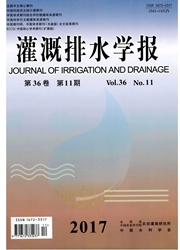

 中文摘要:
中文摘要:
基于改进SWAT模型,以漳河灌区为背号,模拟分析了不同情景下蒸散发及排水比的变化,并进一步分析灌区节水潜力。结果表明,水田蒸散发由大到小为淹灌、间歇灌溉和薄浅湿晒。基于蒸散发消耗调控,研究区现状条件下理论节水率为14.5%.远大于实际节水潜力;与淹灌相比,间歇灌溉和薄浅湿晒节水率分别为1.6%和2.4%。基于排水重复利用,研究区现状条件下理论节水率为16%;塘堰汇流面积比例从现状的30%提高到50%,排水管理节水率及实际灌溉节水率分别为3.8%和1%,而传统的灌溉取水节水率为19.9%;可见,不同计算方法得到的节水潜力存在很大差异。
 英文摘要:
英文摘要:
The changes of evaportranspiration (ET) and drainage fraction under different scenarios in Zhanghe Irrigation District were analyzed based on modified SWAT model, and water-saving potential was discussed further. Results showed ET of paddy field under different irrigation modes in decreasing order was as follow: continues flooding, intermit irrigation, shallow wet and dry. According to the regulation of ET, the theoretical water-saving rate in current situation was 14. 5~, which was far higher than actual water-saving potential ~ Compared with continues flooding, water saving rates were 1.6~, 2.4~ under in- termit irrigation and irrigation mode of shallow wet and dry. Using drainage reuse technique, theoretical water-saving rate was 16~ in current situation~ When the area ratio between pond and watershed catch- ment area increased from 30 ~ to 50 ~, water-saving rate based on drainage was 3.8 % and actual water- saving rate was only 1 ~, while water-saving rate by traditional way was 19.9 ~ ~ so water-saving potential calculated by different methods could lead to vast differences.
 同期刊论文项目
同期刊论文项目
 同项目期刊论文
同项目期刊论文
 期刊信息
期刊信息
